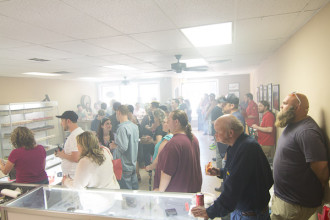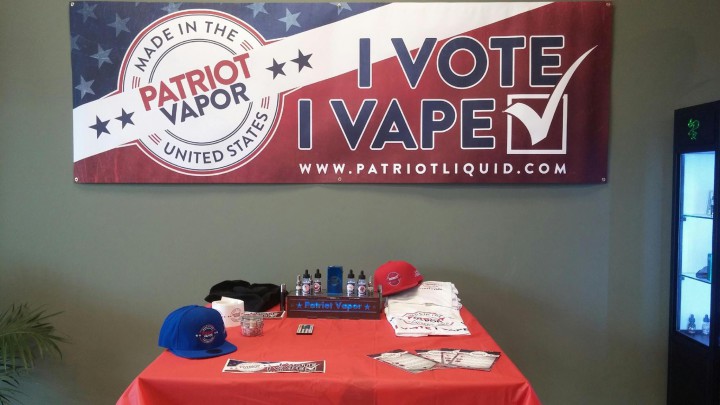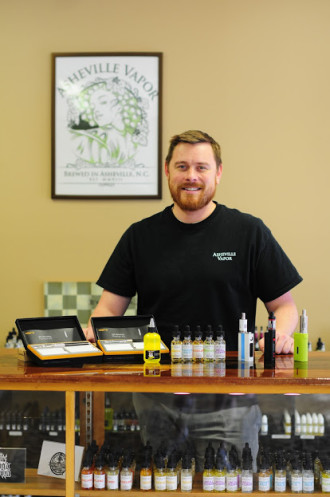There’s a new brume drifting over the mountains these days. It’s not the car fumes from rush-hour traffic on Interstate 240, or the Evergreen Packaging mill in Canton, or the promise of yet another summer afternoon thunderhead.
In various forms, electronic cigarettes are taking Western North Carolina by storm, whether they’re used as a healthier alternative to smoking, an aid to quitting or a pleasurable activity in its own right. But they’re also stirring up intense public debate over health benefits and risks, government regulation and whether the budding vapor industry will settle permanently in the mountains — or go up in a puff of smoke.
The new face of smoking
Although the roots of electronic smoking devices reach back to the mid-1960s, the first modern iterations of e-cigarettes didn’t hit the U.S. market until the early 2000s. By 2007, Chinese brands like Ruyan — created to mitigate the risks of tobacco-related disease — had become common in American gas stations and smoke shops.
“I can remember 10 years ago, talking with my brother about some sort of ‘future cigarette,’” remembers Jeremy Ridgeway, who opened Asheville Vapor in 2013 with Michael Cotellese.
A smoker for more than 15 years, Ridgeway switched to vapor products in 2012 after repeatedly trying to quit. “My father passed away from a smoking-related disease, so it was a big deal for me.”

Early models, says Ridgeway, looked like traditional cigarettes, from the cylindrical shape to a tip that lit up when the user inhaled. Even today, brands like VUSE and Blu are commonly referred to as “cig-alikes.”
More advanced devices were expensive and hard to find in those days, notes Tim Wilson, regional manager at Madvapes. “A device that would be $50 now cost $200” back then, says the former smoker, who started vaping five years ago after buying a new car.
By 2010, improvements in battery power and life and product design, along with an expanding market, began bringing prices down. And since then, business has been booming.
Madvapes, which began in founder Mark Hoogendoorn‘s garage in 2009, now has more than 20 retail locations nationwide. “It’s grown to where we’re the largest distributor on the East Coast,” says Wilson, who manages the four Asheville area stores.
Asheville Vapor opened its Arden storefront in 2013 and has added another location each year, most recently at 333 Merrimon Ave. last month. Ridgeway says there are now about 20 vapor shops in the metro area.
But the combination of rapid industry growth and fierce yet friendly competition, he continues, fuels product innovation. “It’s almost like a fine cuisine. I can envision in the future where there’ll be vapor sommeliers, just like there are in wine.”
Base of the recipe
Due to the diverse and rapidly evolving array of available products and the lack of standard terms in a fledgling industry, any general statement about e-cigarettes risks missing the mark. Despite those complications and the devices’ futuristic aura, however, they all contain the same basic components.
“Every unit is going to have a battery or power source, a tank that holds the liquid and an atomizer that turns it to vapor,” Ridgeway explains. Batteries are usually rechargeable, though they vary widely in power and life span.
Beyond that, however, there’s a basic split between the cig-alikes and “open source” vape units. Cig-alikes, typically made by big tobacco companies, are mostly sold alongside conventional cigarettes in convenience stores. Some are disposable; others have a rechargeable battery and use sealed replacement cartridges containing the liquid.
Open source units, on the other hand, are mostly sold online and in vape shops that don’t generally carry cig-alike brands. they tend to be more durable, more powerful and offer users more options, making them cheaper in the long run.
Many users tinker with the way those units operate. Adjusting the heating element, or coil, for example, allows users to customize their intake, notes Wilson. “If the electrical resistance is lower, it heats up quicker, produces more vapor and gets hotter.”
That’s part of the appeal of the open source units. “You can have tons of different setups, whether it’s a dual box, mechanical box — there are thousands of variations,” says Cotellese. “That’s where you create your own experience.”

And because they’re refillable, open source units also let users choose from among a dazzling array of “e-juice” flavors; cig-alikes generally offer only a few choices. E-juices all contain three basic ingredients — vegetable glycerine, propylene glycol and flavoring — and most also contain varying concentrations of nicotine. Vegetable glycerin, commonly derived from palm or coconut oil, is what produces the visible vapor cloud. Propylene glycol, an aerosol that provides the “throat hit” sensation of smoking, is also found in asthma inhalers, coffee creamers and deodorants, among other products. Flavorings are often similar to those found in candy, and there are even organic blends.
“A lot of people say propylene glycol sounds sketchy,” notes Wilson, “but there’s been more studies about people inhaling [that] than vegetable glycerin.” And though studies have shown that prolonged exposure can dry out air passages, Wilson says most casual users won’t encounter those side effects. And for habitual “vapers,” there are many brands of e-juice containing less propylene glycol.
But in a rapidly changing industry with a do-it-yourself culture, these devices’ popularity is typically short-lived. “Stuff we get in that was popular three months ago, nobody wants now,” says Wilson.
And meanwhile, many open source enthusiasts say the cig-alikes don’t even deserve to be considered in the same category. “In my own personal experience, I know that the [products] the tobacco companies put into the market just don’t work,” says Ridgeway.
Lesser of two evils?
Meanwhile, vapor products’ rapid rise and growing popularity among young people has regulatory bodies scrambling to keep pace. And though many health officials agree that vaping is less harmful than combustible tobacco, the jury’s still out on the long-term effects — and whether vaping leads to nicotine addiction.
A recent NPR report said that as of 2014, 14 percent of U.S. high school students (about 2 million, all told) were using electronic cigarettes, a nearly 10 percent increase from the previous year. That same year, only 9 percent reported smoking conventional cigarettes, according to statistics from the national Centers for Disease Control and Prevention.
And across North Carolina, high school students’ use of vapor products spiked 349 percent between 2011 and 2013, says Jan Shepard, Buncombe County’s public health director. She cites “unregulated marketing and literally thousands of flavors” as possible reasons for vaping’s skyrocketing popularity among youths.
She also cites a 2013 CDC estimate that, nationwide, 160,000 high school students who vape have never used traditional tobacco, sparking fears that vapor products might serve as a gateway to addiction. “Nicotine, which is in most e-cigarettes, is addicting and has been shown to affect brain development of adolescents,” says Shepard. “Of 65 compounds found in e-cigarette aerosol, 26 are listed on the FDA’s list of harmful and potentially harmful substances.” E-cigarette manufacturers, she continues, don’t always properly indicate the amount of nicotine or other potentially harmful ingredients in their products.
Wilson, however, says the industry is taking steps to address at least some concerns. All Madvapes liquids are certified by the American E-Liquid Manufacturing Standards Association, a trade group. New voluntary safety standards based on the association’s recommendations, including things like childproof caps for e-liquid bottles, are expected within the next year.
And while Wilson concedes that no method of smoking is entirely safe, he believes smokers are “much better off with four chemicals than with 3,000 or however many are in cigarettes.”
And for nonsmokers who’d like to try vaping, Wilson recommends sticking with nicotine-free blends, saying, “If you don’t have an addiction, don’t start one.”
Asheville Vapor, notes Cotellese, takes a somewhat different approach. In March, he notes, the company hosted a “90 Days to Nicotine-Free” program at WLOS’ LiveWell Expo. “You can kind of get lost in the culture, but at the end of the day, it’s about helping people get off cigarettes,” says Cotellese, adding, “That’s what we focus on as a company.”

Money, politics and vapor
Earlier this year, the Asheville City Council unanimously approved an ordinance banning e-cigarette use in public parks, on city buses and in city buildings.
But while Wilson says he’s heard some griping from customers, he doesn’t believe the new rules are unreasonable. “Vaping on a bus is kind of ridiculous,” he says. “Some people are going to be rude, but I don’t think that represents the movement or the community.”
One place where Wilson does take issue with the local regulations concerns public servants. “We have a lot of police officers and firefighters who come in here trying to get off tobacco products, because they can’t use them in their vehicles,” he says. “Now they can’t use vapes either.” The ban also applies to city-owned vehicles driven by employees.
Meanwhile, Wilson is keeping an eye on what’s going on in Raleigh; last year, North Carolina became the second state in the nation to place a “sin tax” on e-liquids.
“I don’t think it’s a sin to try to quit doing something that’s harming you,” he argues. Wilson also says it’s not a level playing field, because the cig-alikes typically made by tobacco companies like R.J. Reynolds contain less liquid and therefore generate less tax.
Ridgeway and Cotellese, too, maintain that Big Tobacco lobbyists pushed hard for the sin tax. “Their mindset is, ‘There’s more than one way to skin a cat,’” says Ridgeway. “They might not be able to get [vapor products] banned, but they can create their own and then advocate to tax the other portion of the industry into oblivion.” This, he says, leaves consumers with two choices: “their crappy product or their cigarettes. Either way, they make money.”
Reynolds spokesperson Richard J. Smith, however, calls the North Carolina tax “a good example of appropriate taxation for vapor products … that takes into account the substantial differences between these products and traditional cigarettes and does not tax them at a rate that might discourage adult smokers from considering switching to a smoke-free alternative.”
As for product quality, Smith cites “Vuse’s success at retail,” calling it “the top-selling e-cigarette in the c-store channel” and noting that it uses “the only e-cigarette cartridges designed with a SmartMemory chip inside.”
Smith also calls charges that Reynolds and other big tobacco companies are trying to drive smaller competitors out of business “invalid. Regulation, he continues, “should be based on sound science” and “should be applicable to, and enforced uniformly among, all manufacturers, regardless of size or location of operation.”

A 2014 Wells Fargo Securities report estimated total U.S. sales of vapor products at $2.5 billion, with open source units, accessories and e-juice accounting for $1.5 billion and the rest coming from cig-alikes.
The future direction of the vapor industry, however, hinges largely on the actions of the federal government. In 2009, Congress passed the Family Smoking Prevention and Tobacco Control Act, which charged the Food and Drug Administration with regulating vapor devices and e-liquids.
“To date, the FDA hasn’t been able to fully assess the public health impacts of unregulated tobacco products,” Press Officer Michael Felberbaum said in an email to Xpress. Preliminary testing of e-cigarette cartridges, he added, has revealed varying nicotine content and the presence of potentially toxic chemicals.
Right now, noted Felberbaum, the FDA is focusing on public awareness, usage and perceptions of vapor products, as well as evaluating toxicity and how products are marketed. But that doesn’t necessarily mean bad news for the industry. “If e-cigarettes have reduced toxicity, help smokers quit or do not introduce adolescents to tobacco use, they may have the potential to reduce disease and death,” he wrote.
Meanwhile, local entrepreneurs are taking a wait-and-see approach. Ridgeway, though, fears that a long, expensive FDA approval process for vape units might drive out craft producers and kill the industry’s innovative spirit.
“Basically, billion-dollar companies — i.e., the tobacco companies — would take control,” he predicts. Such changes, he maintains, would “set the industry back 10 years” and remove products proven to help people stop smoking from the market.
Cloudy future
Between the looming threat of further taxes and regulations and the young industry’s uncertain future, local businesses and vapor enthusiasts alike are hanging onto their seats.
“There’s going to be a plateau at some point, but it’s not there yet,” says Wilson, who believes the proof of vapor’s potential is in the pudding. “I smoked and worked in a smoke shop for nine years, and now I’m helping people not smoke. It feels better to me.”
Ridgeway, meanwhile, sees his work in the context of broader cultural shifts. “You’re seeing all these big things, like same-sex marriage, that are just good for humanity. This might be a lofty way to think of it, but there’ll be less suffering in the world because of vapor products.”
Wilson agrees. “When you can make an impact in your life and then get someone else to stop as well, it’s a definite high,” he says. “Kind of like a ‘vape it forward’ type of thing.”






Last session, the North Carolina General Assembly passed two new laws dealing with electronic nicotine delivery systems, or “e-cigarettes.” Senate Bill 530 clarified the definition of these vapor products and prohibited the sale of e-cigarettes to minors in North Carolina, and House Bill 1050 included language that both taxed liquid nicotine at five cents per milliliter and prohibited the use of these devices in State correctional facilities. Expanding further on these protections, last month the General Assembly passed Senate Bill 286 regulating containers of the liquid, which are sold separately and are used to refill the e-cigarette devices. Representative Martin voted in support of the bipartisan legislation..
http://nchouse8.com/a-case-of-the-vapors/
…………………
Hah, vaping is like real nuclear phycics, not for newbies :) A man should be the true expert to make a good choice among all that devices and supplies: ejuices, mechanical mods, vw mods, rba/rda and so on. I’ve discovered a great assortment of starter kits http://gypsyvapes.com/starter-kits, just made vaping newbie’s life much better.